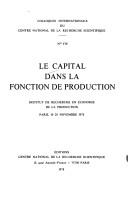| Listing 1 - 10 of 15 | << page >> |
Sort by
|
Book
ISBN: 2717800492 9782717800494 Year: 1975 Publisher: Paris Economica
Abstract | Keywords | Export | Availability | Bookmark
 Loading...
Loading...Choose an application
- Reference Manager
- EndNote
- RefWorks (Direct export to RefWorks)
Capital - Mathematical models --- Austrian school of economics --- Capital
Book
ISBN: 0521228891 0521297036 9780521228893 9780521297035 Year: 1980 Publisher: Cambridge Cambridge University Press
Abstract | Keywords | Export | Availability | Bookmark
 Loading...
Loading...Choose an application
- Reference Manager
- EndNote
- RefWorks (Direct export to RefWorks)
Book
ISBN: 2717802673 9782717802672 Year: 1980 Publisher: Paris Economica
Abstract | Keywords | Export | Availability | Bookmark
 Loading...
Loading...Choose an application
- Reference Manager
- EndNote
- RefWorks (Direct export to RefWorks)

ISBN: 0521096723 0521082943 0511560028 0511864302 9780521096720 9780521082945 9780511560026 Year: 1972 Publisher: Cambridge Cambridge University Press
Abstract | Keywords | Export | Availability | Bookmark
 Loading...
Loading...Choose an application
- Reference Manager
- EndNote
- RefWorks (Direct export to RefWorks)
Capital theory traditionally spans two major compartments of economic theory: the theory of production of both individual products and the total product, and the theory of the distribution of the aggregate product between the different classes of capitalist society. It has always been controversial, partly because the subject matter is difficult and partly because rival ideologies and value systems impinge directly on the subject matter. In the present book the various topics associated with the exchanges between the 'neo-Keynesians' and the 'neo-neoclassicals' are discussed and evaluated. The topics include the measurement of capital, the revival of interest in Irving Fisher's rate of return on investment, the double-switching debate, Sraffa's prelude to a critique of neoclassical theory, and the 'new' theories of the rate of profits in capitalist society.
Capital --- Capital. --- Mathematical models. --- -Capital assets --- Fixed assets --- Economics --- Capitalism --- Infrastructure (Economics) --- Wealth --- Mathematical models --- -Mathematical models --- Capital assets --- Business, Economy and Management --- Capital - Mathematical models
Book
ISBN: 3540055827 0387055827 3642806465 9783540055822 Year: 1971 Volume: 54 Publisher: Berlin : Springer-Verl.,
Abstract | Keywords | Export | Availability | Bookmark
 Loading...
Loading...Choose an application
- Reference Manager
- EndNote
- RefWorks (Direct export to RefWorks)
The following lecture notes were written shortly after I gave a course on capital theory in the winter-semester 1970/71 at the Univer sity of Heidelberg. While the general line of the argument is similar to the one in the course, I have modified and added a large number' of specific points in the process of writing the English version. I should like to emphasize the narrow limitations of the material covered in these notes. I have completely concentrated on steady states of stationary and exponentially growing economies, even up to the point where there is the danger of misleading the reader1 I have done this for several reasons. Other activities have not left me with a sufficient amount of time to be able to find the unifying principle of analysis and mode of presentation for the dynamic aspects of capi tal theory which would have made it worthwhile to add a sizeable book to the large body of literature in this field. On the other hand over the last couple of years I have become increasingly aware that some of the results in steady state capital theory (which could be derived without too much mathematical effort) are of relevance in present day dis cussions about the political role of economic theory and the relative merits of orthodox and radical economics. Also these results seemed not to be known by' mO$ of the participants in these discussions.
Capital --- 330.14 --- AA / International- internationaal --- 338.03 --- Kapitaal. Kapitaalbegrip. Kapitaaltheorie. Kapitaalwinst. Meerwaarde. Kapitaalallocatie. Kapitaalaccumulatie. Kapitaalconcentratie. Kapitaalvorming --- Kapitaal. --- Business & Economics --- Economic Theory --- 330.14 Kapitaal. Kapitaalbegrip. Kapitaaltheorie. Kapitaalwinst. Meerwaarde. Kapitaalallocatie. Kapitaalaccumulatie. Kapitaalconcentratie. Kapitaalvorming --- Saving and investment --- Production functions (Economic theory) --- Mathematical models --- Kapitaal --- Capital - Mathematical models --- Saving and investment - Mathematical models --- Economie mathematique --- Modeles mathematiques

ISBN: 2222022940 9782222022947 Year: 1978 Volume: 570 Publisher: Paris CNRS
Abstract | Keywords | Export | Availability | Bookmark
 Loading...
Loading...Choose an application
- Reference Manager
- EndNote
- RefWorks (Direct export to RefWorks)
Production functions (Economic theory) --- Capital --- congresses --- Mathematical models --- Congresses --- -Production functions (Economic theory) --- -Functions, Production (Economic theory) --- Production (Economic theory) --- Economics --- Capital assets --- Fixed assets --- Capitalism --- Infrastructure (Economics) --- Wealth --- -Congresses --- Conferences - Meetings --- -Mathematical models --- Functions, Production (Economic theory) --- Mathematical models&delete& --- Production functions (Economic theory) - congresses --- Capital - Mathematical models - Congresses
Book
ISBN: 383491326X 3834981931 Year: 2009 Publisher: Wiesbaden : Gabler / GWV Fachverlage GmbH,
Abstract | Keywords | Export | Availability | Bookmark
 Loading...
Loading...Choose an application
- Reference Manager
- EndNote
- RefWorks (Direct export to RefWorks)
Company taxation is an important element for the establishment and the completion of the Internal Market. Against this background, the European Commission recommends the harmonisation of the tax base in the European Union. Carsten Wendt analyses the necessity, the concept as well as potential advantages and effects of a common tax base for multinational enterprises in the European Union. He addresses important issues concerning a common tax base, such as the definition of the consolidated group, the technique and scope of consolidation and the formula used to allocate the consolidated tax base among the involved member states. The author provides alternative options to solve these issues and concludes that a common tax base as intended by the European Commission would remedy many of the existing tax obstacles for multinational enterprises in the EU. However, distortions will remain, mainly because member states retain their sovereignty to set their tax rates independently and the territorial scope of a common tax base has to be restricted to group entities located within the EU.
Capital -- Mathematical models. --- Capital investments -- Mathematical models. --- Corporations -- Taxation -- European Union countries. --- Corporations -- Taxation. --- Commerce --- Management --- Business & Economics --- Accounting --- Industrial Management --- International business enterprises --- Taxation --- Business enterprises, International --- Corporations, International --- Global corporations --- International corporations --- MNEs (International business enterprises) --- Multinational corporations --- Multinational enterprises --- Transnational corporations --- Business. --- Tax accounting. --- Tax laws. --- Business and Management. --- Business Taxation/Tax Law. --- Business enterprises --- Corporations --- Joint ventures --- Finance, Public --- Tax laws --- Tax legislation --- Tax regulations --- Law

ISBN: 087014264X 9780870142642 Year: 1974 Volume: 4 Publisher: New York, N.Y. National Bureau of Economic Research
Abstract | Keywords | Export | Availability | Bookmark
 Loading...
Loading...Choose an application
- Reference Manager
- EndNote
- RefWorks (Direct export to RefWorks)
Income --- United States --- Income distribution --- Human capital --- Mathematical models --- 331.1 --- 331.2 --- -Income distribution --- -#SBIB:316.8H15 --- Human assets --- Human beings --- Human resources --- Capital --- Labor supply --- Distribution of income --- Income inequality --- Inequality of income --- Distribution (Economic theory) --- Disposable income --- Theorie van de arbeidsverhoudingen. Human relations --- Loon. Salaris. Vergoeding --(algemeen) --- Mathematical models. --- Welzijns- en sociale problemen: sociale ongelijkheid en armoede --- Economic value --- 331.2 Loon. Salaris. Vergoeding --(algemeen) --- 331.1 Theorie van de arbeidsverhoudingen. Human relations --- -331.1 Theorie van de arbeidsverhoudingen. Human relations --- Income distribution - United States - Mathematical models --- Human capital - United States - Mathematical models --- Income distribution - Mathematical models --- Human capital - Mathematical models --- United States of America
Book
ISBN: 2717800468 9782717800463 Year: 1978 Publisher: Paris : Économica,
Abstract | Keywords | Export | Availability | Bookmark
 Loading...
Loading...Choose an application
- Reference Manager
- EndNote
- RefWorks (Direct export to RefWorks)
Human capital --- Education --- Mathematical models --- Economic aspects --- Ressources humaines --- AA / International- internationaal --- 658.334 --- -Human capital --- -marche du travail --- management --- Human assets --- Human beings --- Human resources --- Capital --- Labor supply --- Children --- Education, Primitive --- Education of children --- Human resource development --- Instruction --- Pedagogy --- Schooling --- Students --- Youth --- Civilization --- Learning and scholarship --- Mental discipline --- Schools --- Teaching --- Training --- Beroepsvorming en -oriëntatie. Menselijke investeringen. Menselijk kapitaal. --- -Mathematical models --- arbeidsmarkt --- Economic value --- marche du travail --- Economic aspects&delete& --- Beroepsvorming en -oriëntatie. Menselijke investeringen. Menselijk kapitaal --- Ressources humaines. --- Human capital - Mathematical models --- Education - Economic aspects - Mathematical models
Book
ISBN: 271780286X 9782717802863 Year: 1980 Publisher: Paris : Économica,
Abstract | Keywords | Export | Availability | Bookmark
 Loading...
Loading...Choose an application
- Reference Manager
- EndNote
- RefWorks (Direct export to RefWorks)
Production functions (Economic theory) --- Capital --- Economic development --- Mathematical models. --- AA / International- internationaal --- 338.8 --- 338.40 --- -338.040 --- -Production functions (Economic theory) --- 338.00 --- Functions, Production (Economic theory) --- Production (Economic theory) --- Economics --- Development, Economic --- Economic growth --- Growth, Economic --- Economic policy --- Statics and dynamics (Social sciences) --- Development economics --- Resource curse --- Capital assets --- Fixed assets --- Capitalism --- Infrastructure (Economics) --- Wealth --- Economische groei. --- Industrieel beleid: algemeenheden. --- Mathematical models --- Ondernemingen: algemeenheden. --- Theorie van de productie. --- 338.040 --- Growth models (Economics) --- Theorie van de productie --- Ondernemingen: algemeenheden --- Industrieel beleid: algemeenheden --- Economische groei --- Capital - Mathematical models --- Economic development - Mathematical models --- Fonctions de production (théorie économique) --- Développement économique --- modèles mathématiques
| Listing 1 - 10 of 15 | << page >> |
Sort by
|

 Search
Search Feedback
Feedback About UniCat
About UniCat  Help
Help News
News